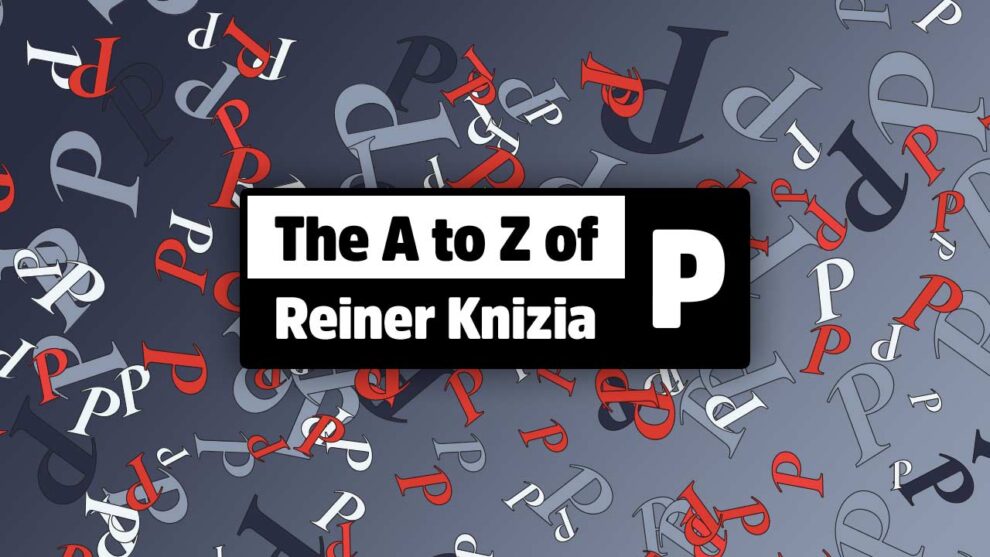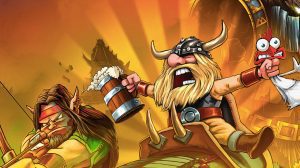The year 2025 marks the 40th anniversary of Dr Reiner Knizia’s career as a board game designer – his first published game, Complica, was released in a magazine in 1985 (although he’d self-published games before then as well).
Since then, Knizia has designed and published over 800 games and expansions, many of which are critically acclaimed. Put simply, Reiner Knizia is the landscape on which all other modern designers build their houses.
To celebrate Knizia’s career and back catalogue, Meeple Mountain are taking things back to basics to consider the ABC of Reiner Knizia: one game for each of the 26 letters of the alphabet.
This time: The Letter ‘P’.
P – Pickomino (2005)
“A gambling game in the finest chicken tradition.”
Do we really need to say more?
Oh, ok then. Pickomino (also known as Heckmeck) is the older sibling of 2006’s Risk Express (better known as Age of War, which we covered right at the start of our alphabet). Players act as chickens, rolling dice to collect worms from the centre of the table or from other players. You roll eight dice, choose a value to set aside (e.g. all the 4s that you rolled) and then decide to stop or reroll the remaining dice. This goes on until you choose to stop or you bust by not being able to set aside any dice (as you can’t set aside dice with the same value as dice you’ve already set aside).
The goal of Pickomino is to roll a total that’s equal to or greater than one of the face up worm tiles on the table. The higher the number, the more worms on the tile. Tiles can be stolen from other players, whilst busting causes tiles to be lost from the centre, acting as a timer to prevent the game from dragging on too long. And that’s about it for Pickomino – most worms wins.
Don’t think that sounds like a recipe for success? You wouldn’t be the only doubter. Publishers just weren’t interested. Speaking in an interview with King & Pawn, Knizia said that it took time, perseverance and his own belief in the game to see it hatched. Rather like Lost Cities, the initially unwanted game gained a big following on release, selling more than a million copies and laying a family of chicks.
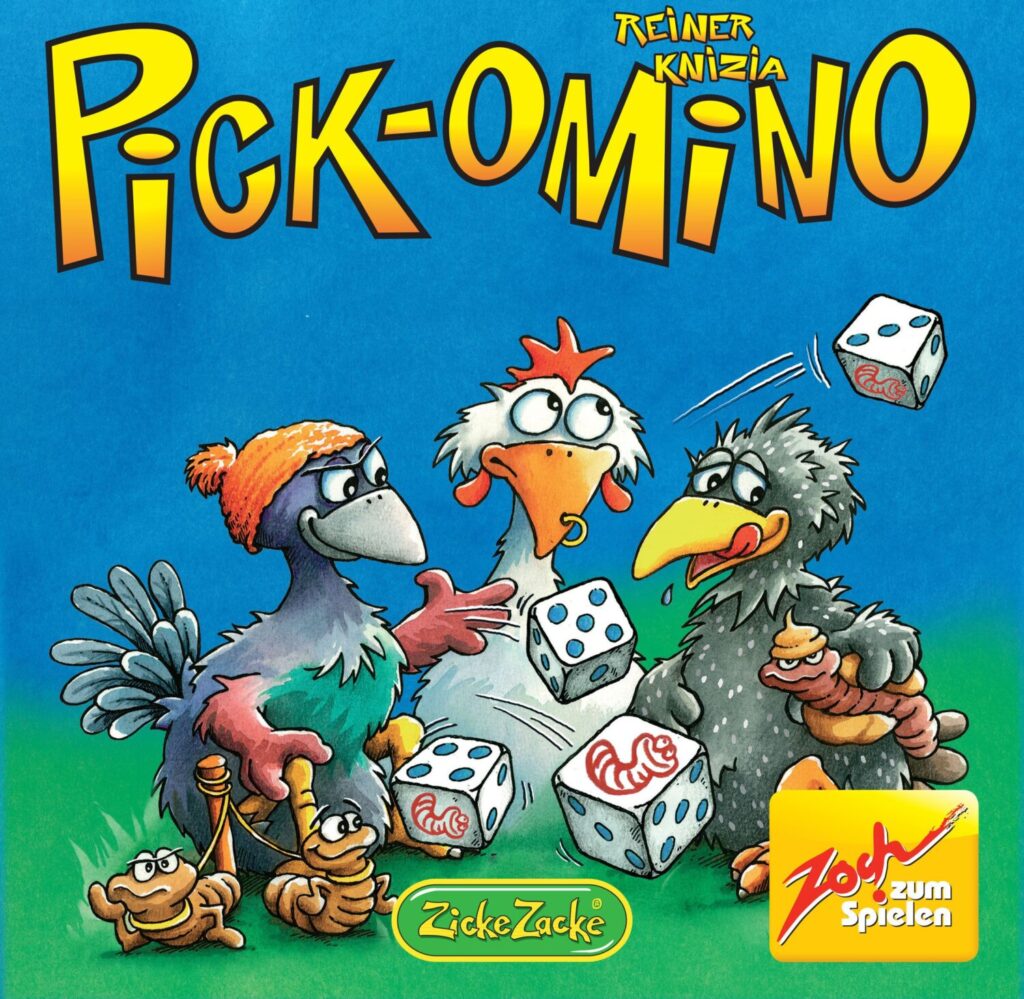
Pickomino’s success, Knizia said in an interview with Mojo Nation, is partly down to the chickens. Originally it had a different theme and lacked that certain something to make it memorable. Changing the theme to chickens gave the game lots of character and helped it to take off. “A good game that grabs people is more important than anything else,” Knizia said at a panel at Origins 2008, “but you can never tell what’s going to grab people”. Apparently, it’s poultry!
With so many copies sold, Pickomino gives players more to enjoy than just comedy chickens. “This game gets an easy recommendation from me,” says Egg Shen on There Will Be Games, “the BBQ worms and chicken theme is incredibly disarming and the gambling, press your luck dice rolling is easy to pick up and more importantly, addictive”. It’s not perfect, however, and the main complaint people have is the game going on for too long at higher player counts.
Knizia was clearly exploring the design space when designing Pickomino, and returned to it when creating a short Risk game. The resulting game, Risk Express (later released as Age of War), and Pickomino differ in their mechanics of dice rolling, how you collect and score points and the feelings they evoke, but with their shared interests in push-your-luck dice rolling and stealing they’re undoubtedly close relatives.
Indeed, Pickomino and Age of War are part of a whole genealogy of games, from Pickomino’s elderly ancestor Octo (released in 1990 within his book Dice Games Properly Explained) which is the originator of Pickomino’s dice rolling mechanic, to more modern cousins such as 2022’s No Mercy. Knizia superfan Laszlo Molnar has delved deep into the Pickomino lineage and, for those interested in exploring it further, we recommend his ‘The Real Pickomino Family’ list.

For many players, however, Pickomino remains the best of the bunch. Knizia may have designed plenty of push-your-luck dice games, but “this is his dice game masterpiece,” says ‘Detailed Reviewer’ Neil Thomson.
Whilst Pickomino is a simple game, the probabilities behind it mean that no decision is completely straightforward. Of course, numbers are Knizia’s thing: he earned his PhD in Mathematics in 1986 at the University of Ulm, Germany, with his thesis ‘Charakterisierung von mehrdimensionalen Perron-Integralen’ (‘Characterization of multidimensional Perron integrals’ – No, the translation into English didn’t help us understand it either!).
Following careers in software development, IT and banking, Knizia became a full-time game designer in 1998 and hasn’t looked back since. Except… so many of his designs draw on his interest in mathematics. Indeed, Thomson has summed up Knizia games, perhaps unfairly, as “math hidden behind a thin veneer of cover art and scoring mechanics”.
Even seemingly simple games such as Pickomino are underpinned by maths. Just ask Martín Revuelta, designer of the AI behind the Pickomino app. Fascinated by Pickomino, Revuelta designed the AI program in his spare time before reaching out to Knizia who put him in touch with United Soft Media. The collaboration led to the finished app in 2015.
The (sadly no longer available app) aside, Pickomino’s offspring include an expansion, deluxe box, children’s edition, card-based reimplementation (“sneakily clever and surprisingly solid,” according to Bitewing Games’ Nick Murray) and Heckmeck Barbecue, a twist on the original with a board and broiling. All are gloriously illustrated by one of the great board game artists: Doris Matthäus (whose most famous work is on the original editions of Carcassonne and its many expansions).
Knizia, Matthäus and chickens – a match made in gaming heaven! As if that wasn’t enough, Pickomino is also part of The Chicken Family of Zoch, a collection of 10 poultry-preoccupied playthings published by Zoch Verlag between 1996 and 2008, all of which are also illustrated by Matthäus.
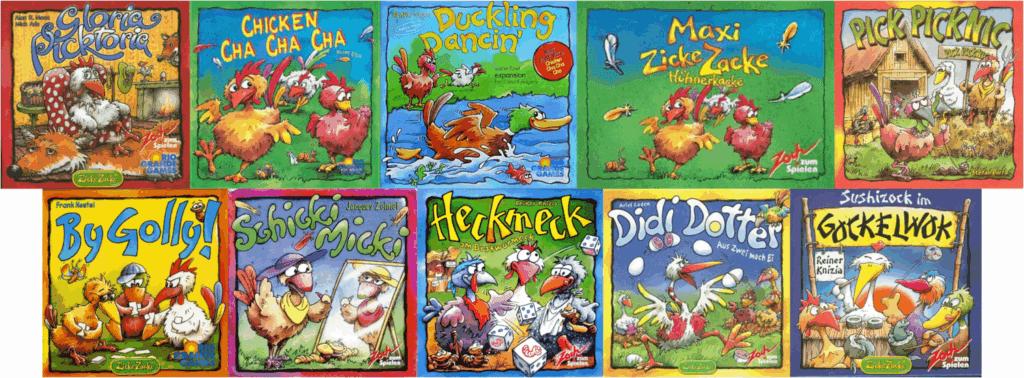
Only one other game in the Chicken Family of Zoch was designed by Knizia. Sushizock im Gockelwok, aka Sushi Bar, released in 2008 is a sequel of sorts to Pickomino. Whilst it adds some interesting twists, its dice rolling is too restrictive for some. Other notable designers in the Chicken Family series include Alan R. Moon (Ticket to Ride), Stefan Dorra (Valletta), Jacques Zeimet (Cockroach Poker) and Zoch Verlag co-founder Klaus Zoch (The Estates).
The Chicken Family of Zoch is also one reason why the game’s English language title is Pickomino. Of course, the worm tiles are like dominos and players spend the game picking them, but the ‘pick’ theme also features in other Chicken Family releases such as Pick Picknic, Gloria Picktoria and even Pique Plume (the French version of Chicken Cha Cha Cha). These days Pickomino is just as likely to be referred to as Heckmeck, the original German title that also harkens back to earlier German titles in the Chicken Family such as Hick Hack (aka Pick Picknic) and Zicke Zacke (aka Chicken Cha Cha Cha). Aren’t words wonderful!
Pickomino, then, is exactly as advertised: a gambling game in the finest chicken (family) tradition.
Prioritising Preferred Pastimes
Picking one ‘P’ game in particular was no picnic, and we’d like to present some prime ‘P’ possibilities:
Palazzo – Released in 2005, Palazzo has simple rules, a quick play time, lots of auctions and more shades of beige than Farrow & Ball. The aim of Palazzo is to have the most magnificent palaces, which equates to palaces that are tall, made of a single building material and with many windows and doors. Despite its dry presentation, “Dr Knizia has crafted a perfect little experience,” says Nick Murray of Bitewing Games, “that provides just the right blend of mechanisms to feel tight and refreshing”.
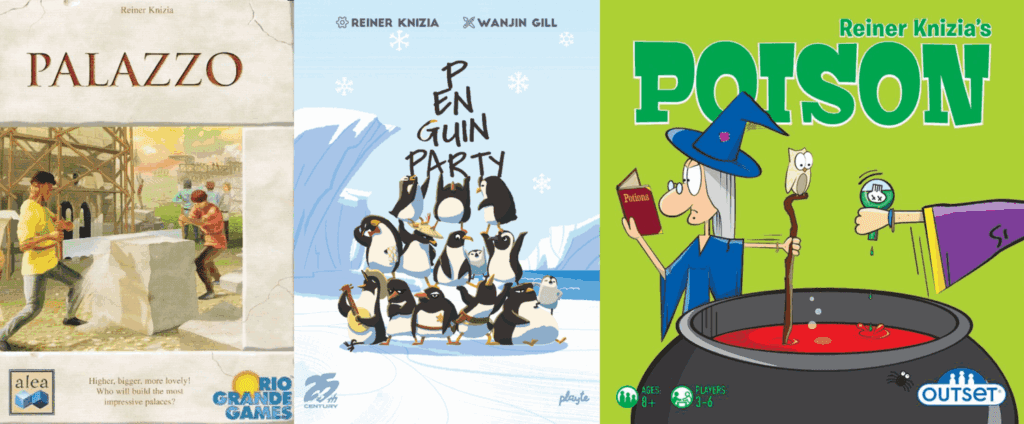
Penguin Party – If you’re after more ‘P’ based Kn-avian goodness, then 2008’s Penguin Party is worth a look for flightless filler fun. Based on the 2007 release Penguin (which had plastic penguin figures you were actually stacking), this quick card game involves playing cards to create a pyramid of ever-shrinking penguin colours. Players are trying to empty their hands of cards but can’t play a penguin if there isn’t a matching colour supporting it in the pyramid. Simple enough for kids as young as 6, there’s enough to entertain a table of adults for a few minutes as well. Strangely, it was reimplemented in 2014 as Game of Thrones: Westeros Intrigue, the child-friendly gameplay at odds with the darker theme of families being eliminated.
Pick a Pen Series – Four games all using the same hook: you roll coloured pencils instead of dice. In each game you’re selecting both the colour of the pencil and the number or symbol showing on the top edge of the rolled pencil. Released in 2023 (Reefs, Crypts and Gardens) and 2024 (Hackers), the games are interesting tweaks to the roll-and-write genre but perhaps never manage to escape their gimmick well enough to stand out in a crowded environment.

Poison – Released in 2005 and recommended for the 2009 Spiel des Jahres, Poison has hints of 2002’s Foodie Forest (Too Many Cooks) about it. Players add numbered cards to one of three central cauldrons, trying to avoid the total sum of a cauldron going above 13. Hit 13 or more and you take all the cards from the cauldron but if you get the most cards of one of the game’s three suits then you can discard them, which you want to do since it’s the lowest score (cards) that wins. Simple and fun, Poison has also been known as Baker’s Dozen and Friday the 13th for obvious reasons.
Pollen – A reworking of 2009’s Samurai: The Card Game, itself a reimplementation of Knizia’s seminal Samurai, 2023’s Pollen is as beautiful as it is deadly, thanks to gorgeous art by Beth Sobel. The lovely flowers and insects of the cards and tokens hide a sharp game where every turn has you trying to win wars on multiple fronts. “Pollen is classic Knizian magic,” says Meeple Mountain’s Andrew Lynch in his review of Pollen, “It is full of complex consequences that spring out of simple decisions. Each time I play, I learn something new that I want to bring forward into my next game.”

Priests of Ra – Do you like playing Ra and want something that’s the same but also a little different? Well, Priests of Ra is the game for you! A direct sequel to Ra and released a decade after the original in 2009, Priests of Ra uses exactly the same auction mechanism as its elder sibling but changes the way tiles score. The main draw is tiles that are double sided, allowing players to choose how to use them. Is one Ra game better than the other? To quote Leo Getz: “You are my friends. You are not better friends than Froggy. You’re just different.” A lovely sentiment, but most people reckon that the original Ra is both different and better than Priests of Ra. Still, it’s worth trying if you’re a Ra fan.
Pumafiosi – Reimplementing 2004’s Rooster Booster, Pumafiosi helped launch Bitewing Games into the publishing business in 2022, being the second title in their ‘Criminal Capers’ trilogy (alongside Knizia’s Soda Smugglers and Hot Lead). It’s safe to say that the industry has changed in the years since and Knizia’s stocks have skyrocketed, in part thanks to the Bitewing-Knizia partnership that’s also given us Zoo Vadis, Cascadero, Cascadito, Cat Blues: The Big Gig, Iliad, Ichor, Silos, Ego and Orbit (with Qin’s reimplementation Gazebo on the horizon). Pumafiosi is a simple game of trying to play the second-highest card each round, navigating the slippy rungs of the Puma Mafiosi hierarchy. “Much of the strategy in Pumafiosi relates to cutting players down to size,” says Lynch in his review of Pumafiosi, “it’s a fun, sharp, interactive game with light rules. You can’t beat that.”
–
And so ‘P’ is past. How did we perform? Perhaps our proof was poor and you would prefer us to proffer our paltry heads for some painful punishment. Or were we perfect in our perceptive and persuasive picks? How would you have profiled ‘P’? Propose your point of view in the comments below and peruse the rest of the Reiner Knizia Alphabet here!


